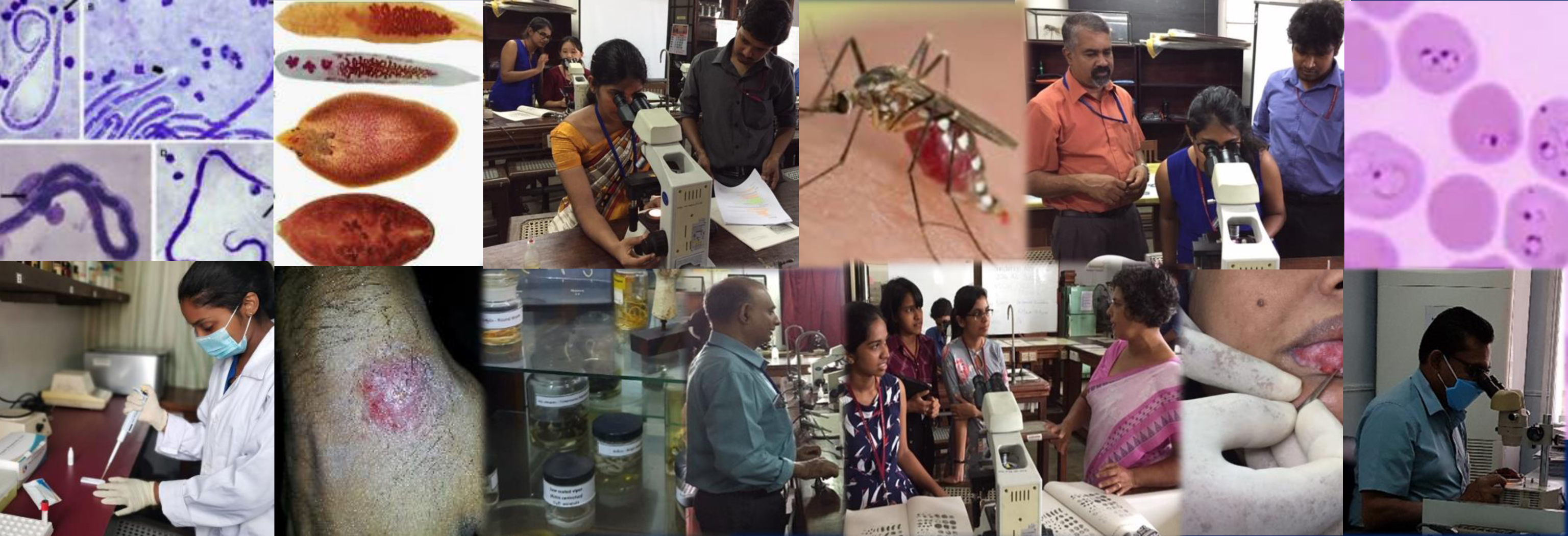
Vector Research
 The research based on vectors plays a considerable role in parasitic diseases. Though Sri Lanka has achieved elimination status from diseases like malaria and filariasis which were the major parasitic vector borne diseases burdened Sri Lanka in the past the emerging infections like leishmaniasis transmitted by sandflies and spread of dengue are currently been considered as a threat to health sector. The parasitic disease research unit (previously MRU) undertook several research projects on anopheline mosquitoes. The disease transmission, parasite propagation in the laboratory using anopheline mosquitoes, epidemiology, insecticide susceptibility and vector surveillance were carried out.
The research based on vectors plays a considerable role in parasitic diseases. Though Sri Lanka has achieved elimination status from diseases like malaria and filariasis which were the major parasitic vector borne diseases burdened Sri Lanka in the past the emerging infections like leishmaniasis transmitted by sandflies and spread of dengue are currently been considered as a threat to health sector. The parasitic disease research unit (previously MRU) undertook several research projects on anopheline mosquitoes. The disease transmission, parasite propagation in the laboratory using anopheline mosquitoes, epidemiology, insecticide susceptibility and vector surveillance were carried out.
Mosquito Colony
 The Parasitic research unit owns one of the longest running Anopheles tessellates colonies maintained since 1984. This colony provided the necessary mosquitoes for vaccine development projects to develop parasite antigen through laboratory infected animal models. Though no malaria transmission now occurs in the country the colony is available for research purposes. The elective students and research students are continued to be trained on entomological techniques like mosquito dissections, morphological identification of adult and larval stages of mosquitoes and colony maintenance.
The Parasitic research unit owns one of the longest running Anopheles tessellates colonies maintained since 1984. This colony provided the necessary mosquitoes for vaccine development projects to develop parasite antigen through laboratory infected animal models. Though no malaria transmission now occurs in the country the colony is available for research purposes. The elective students and research students are continued to be trained on entomological techniques like mosquito dissections, morphological identification of adult and larval stages of mosquitoes and colony maintenance.
Sandfly Colony
Phlebotomus argentipes, which is considered as the probable vector of leishmaniasis in Sri Lanka is maintained in a separate insectory . The colony was initiated in 2013 and provides sandflies for several ongoing research projects.
- Surveillance study on distribution of sandflies in disease endemic and non endemic areas.
- Detailed analysis of the antigens present in sandfly saliva.
- Study on effect of salivary secretions on disease and immunity in human host and laboratory animals.
- Insecticide susceptibility patterns of sandflies and resistance mechanisms
- Senanayake S A S C , Abeyewicreme W, Dotson E M and Karunaweera N D (2015) Characteristics of phlebotomine sandflies in selected areas of Sri Lanka. Southeast Asian J Trop Med Public Health 46 (6) , 993-1004.
- Pathirage DRK, Karunaratne SHPP, Senanayake SC, Karunaweera ND. (2020). Insecticide susceptibility of the sand fly leishmaniasis vector Phlebotomus argentipes in Sri Lanka. Parasit Vectors 13(1): 246. https://doi.org/10.1186/s13071-020-04117-y
- Senanayake S A S C, ,Karunaweera N D (2015) Insecticide susceptibility of wild caught sandflies from Hambantota Distraict 128th international Medical Congress (2014) of Sri Lanka Medical Association
- Senanayake S A S C, Karunarathne SH P P ,Karunaweera N D (2014) First Laboratory-bred sandfly progeny for entomological studies in Leishmaniasis, 127th international Medical Congress (2014) of Sri Lanka Medical Association
- Senanayake S A S C , Karunarathne S H P P , J Valenzula J, Karunaweera N D (2014) Laboratory rearing and morphological characterization of salivary glands of Phlebotomus argentipes glaucus from Sri Lanka, 3rd Annual conference, 2014, Sri Lanka Society for Microbiology
- Senanayake S A S C, Dotson E M, Karunaweera N D(2013).Aggregation behavior of Phlebotomus argentipes glaucus .Annual Research Symposium, University of Colombo 2013. Pp 141.
- Senanayake S A S C, Dotson E M, Karunaweera N D (2012). Characterization of leishmaniasis vectors in selected areas in Sri Lanka. Annual Research Symposium, University of Colombo, pp252-253.
- Senanayake S A S C , Dotson E, Karunaweera N D (2012). Distribution and behavioral aspects of phlebotomine sandflies in selected areas of Sri Lanka. 44th APACPH Conference..pp1-87.
- Senanayake S A S C , E Dotson E , Karunaweera N D (2012). Study of host preference of Phlebotomine sandflies in Sri Lanka, Sri Lanka Medical Association 125th Anniversary International Medical congress. OP43.
- Senanayake S A S C, Abeyewicreme W, Abeysinghe R R ,Dotson E M Karunaweera N D. Phlebotomus argentipes possible vector of leishmaniasis in Sri Lanka (2011)Proceedings of Annual Research symposium, University of Colombo .p 220-221